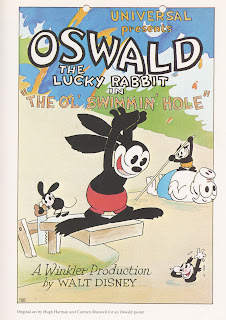Rubberhosing will be a blog about the Rubber Hose Animation Style from the late 1920's to the 1930's.
According to
Wikipedia's definition:
"Rubber hose animation was the first animation style that became standardized in the American animation industry.
In the early days of the hand drawn animation in the 1920s, the studios' main areas were not Hollywood, but New York City. Back then animation was still such a new phenomenon that there weren't any experienced animators around. Yet there were skilled artists working in newspapers, creating comic strips in a time when even the comic strips themselves were relatively new. Many of them became fascinated with the introduction of moving drawings, and saw them as new possibilities and new challenges to use their skills on something they found more exciting than the newspaper strips.
For this reason, many of the first cartoons had many similarities with moving comic strips. The artists experimented with what worked and did not, what they could do and what they couldn't. In the strips they didn't need to think of their work in three dimension or how they moved, but at the same time it gave them the opportunity to introduce gags and elements not possible in comic stills. And because the drawings would have to be mass produced to create the illusion of movement, they had to come up with a compromise where characters were less detailed and time consuming, but at the same time alive and complex enough.
As the animators gained experience through trial, error and collaborations, the cartoons became more professional and dominated by specific rules in how to make them.
The studios would have to be very sensitive to any new trend in the business to be able to survive in the competition. One of the consequences of this was that the most successful cartoons, characters and studios would have a strong influence on the rest of the industry. The first with such a strong influence was Otto Messmer's Felix the Cat, causing copies of Felix the Cat to be produced by others' studios. Also the style and design had a great impact, and this feedback mechanism with successful cartoons affecting the rest of the animation business combined with the natural evolution of animation, would at the end result in a dominating design that would be known as the rubber hose style, even if there were individual differences between the studios. Bill Nolan (aka William Nolan) is credited for the perfection of this animation style.
The rubber hose animation gradually faded away when further sophistication of the cartoons was introduced, especially by Walt Disney who decided he wanted to make his cartoons more realistic and have them to follow much of the same rules as live action, a direction that would later be named full animation. He is quoted to have said that in animation, you can do everything you can't in live action, which could mean he to some degree saw animation as a possibility to make it a potential surrogate for live action where he could do what was impossible in live action once it achieved his demands of realism. This was a direction that didn't allow the fluid bodies seen in rubber hose, and due to Disney's success, this trend was spreading to the remaining producers of cartoons on demands from their distributors, most of them located in Hollywood at this time.
Later cartoons would sometimes include some of the trademarks of rubber hose, such as Tex Avery or Ren and Stimpy, but the original style and its influence became a part of animation history by the start of the 1940s."
Many of our subjects and themes will be:
-Ub Iwerks
-The Fleischers
-Popeye
-Neo - Rubberhouse (Augenblick, Adventure Time, and more...)
















